Key OSR risk management techniques highlighted in grower study
8th August 2022
Ten of the most widely-used techniques to reduce winter OSR risk are rated particularly highly for their effectiveness by growers in the latest annual Dekalb benchmarking study, providing a valuable focus for those looking to make the most of the coming season’s excellent OSR-earning opportunities.
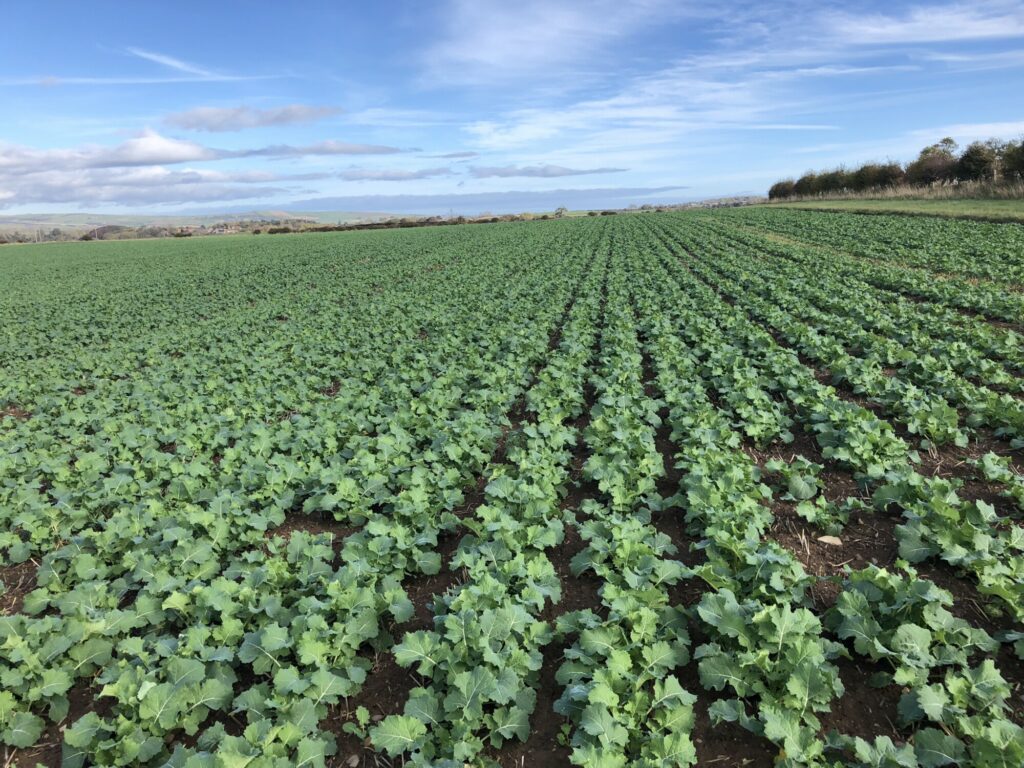
The most recent in Bayer’s three-year series of annual studies involved more than 170 growers with
12,500ha of OSR in the ground well-spread across the main rapeseed-growing areas of the country. As well as continuing to chart relative crop performance, it moved on from the primary cabbage stem flea beetle (CSFB) management focus of the 2020 and 2021 studies to look more broadly at the key techniques being employed to minimise OSR-growing risks.
Of the 30 main general management, establishment and subsequent agronomic practices explored, it identified nine being used by more than half of growers, a further nine by more than a third but less than half, and a dozen only being employed by a clear minority.
“Given its critical importance to crop performance, it is hardly surprising that eight of the nine most widely-employed techniques relate to decision-making and management up to and at establishment,” observes study co-ordinator, Richard Williams. “Nor that the focus for all of them is ensuring the crop goes into the spring in the best possible condition (Figure 1).
Figure 1: Most widely used OSR risk management techniques
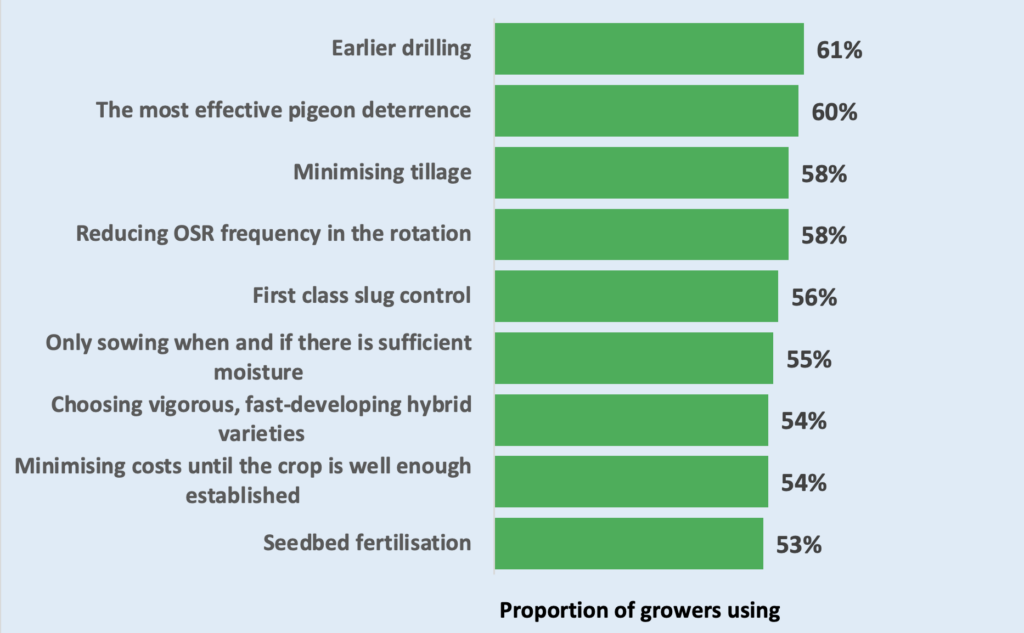
Source: Dekalb National Winter OSR Management Study 2022, Bayer.
“While combatting CSFB clearly continues to be a driver for many, most of the key techniques being employed – like minimising tillage, less frequent OSR in the rotation, only sowing when and if there is sufficient moisture, choosing vigorous, fast-developing varieties and seedbed fertilisation – are what most people would consider best practice these days, regardless of flea beetle pressure. And it’s good to see tackling the traditional crop pests of slugs and pigeons continues to be a priority.
“Even though it remains associated with better crop performance in our studies and is being practised by an increasing number of growers prompted by the CSFB threat, earlier drilling is something that needs to be undertaken with a little more caution,” he suggests.
“Sowing in the first half of August can undoubtedly be a good way of securing better establishment, giving crops more thermal time to develop ahead of winter and getting them securely beyond their most vulnerable stage before the peak of flea beetle migration. But the earliest sowing, in particular, can bring with it a number of significant challenges which need to be effectively managed.
“An increased threat from light leaf spot is especially important to guard against here. As is a higher lodging risk and the danger of excessive pre-winter development in a mild season such as the most recent.
“Indeed, almost half those sowing the bulk of their crops in early August in this season’s study reported mid-February GAIs of 2.5 or more and nearly 10% 3.5 or more. While this may have helped them cope with pigeon damage and allowed spring nitrogen economies, over-grown canopies are always more difficult to manage and tend to compromise both crop productivity and standing ability at anything other than the lowest sowing rates. So, this must be a clear watch out, management-wise.
“Varieties with the strongest standing power and light leaf spot resistance are especially important for early drilling and TuYV resistance can be a valuable bonus too,” he advises. “Vigorously-establishing varieties that are faster-than-average in their autumn development remain essentials, but it’s best to avoid the fastest autumn developers in this slot. Early autumn applications of metconazole would also be well-advised for particularly-forward crops.”
Among the further nine fairly widely-used risk management techniques, Richard Williams notes that, once again, the majority relate to decisions before or at establishment (Figure 2).
Figure 2: Reasonably widely used OSR risk management techniques
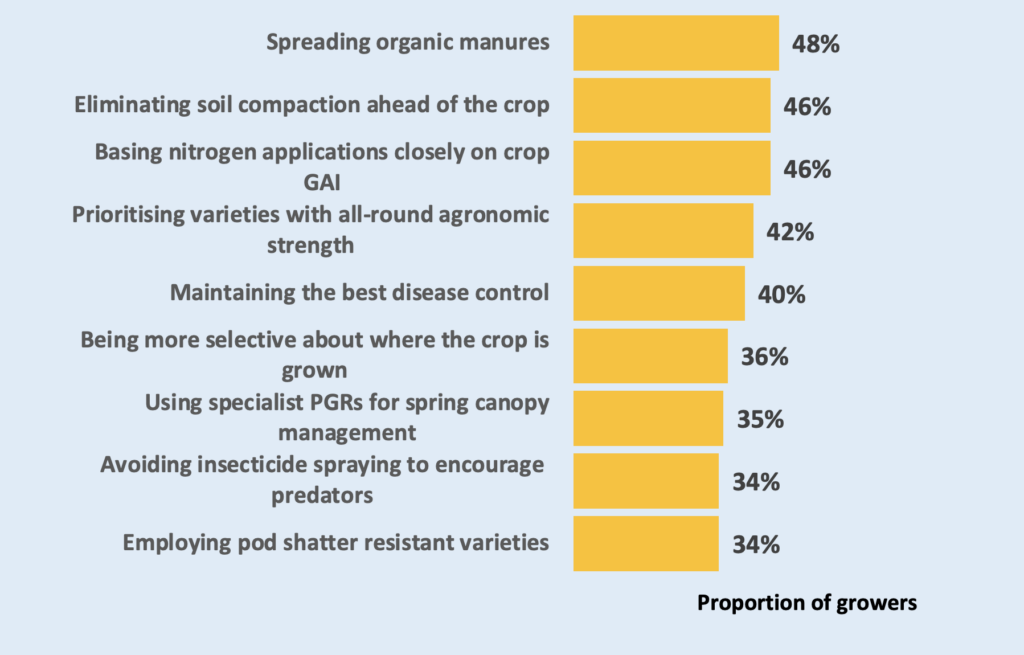
Source: Dekalb National Winter OSR Management Study 2022, Bayer.
“It’s particularly encouraging to see how many growers are now deliberately avoiding insecticide spraying at establishment to encourage predators,” he comments.
“The relatively few growers reporting more than moderate challenges with CSFB make it difficult to be certain here, but the data suggest that those avoiding insecticides altogether as a management tool to reduce cropping risk are not necessarily suffering as a result.
“Indeed, they are taking a noticeably higher proportion of their crops to harvest than those continuing to be committed to autumn insecticides and appear relatively more positive about their crop condition and potential too.”
Equally revealing in the latest Dekalb study are the techniques only being used by a minority of growers (Figure 3).
Figure 3: Less widely used risk management techniques
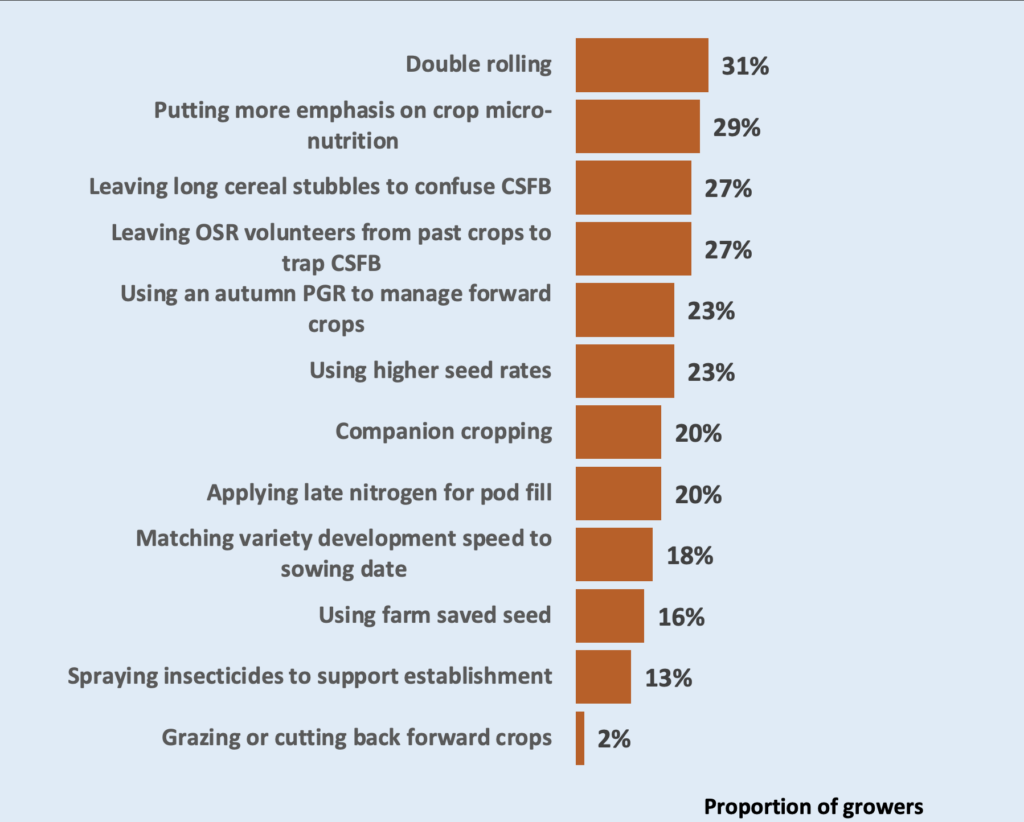
Source: Dekalb National Winter OSR Management Study 2022, Bayer.
Of these, Richard Williams highlights a number which are proving impractical for many, including leaving long cereal stubbles, companion cropping and grazing or cutting back forward crops; several, like double rolling, using an autumn PGR and matching variety development speed to sowing date that should probably be used more widely; and a number which thoroughly deserve to be ‘also rans.’
“However tempting it may be to try to support establishment with insecticide sprays where crops are really challenged by CSFB, in most cases we know they have little real impact on the pest while damaging a number of important insect predators,” he points out. “So, the more people that avoid this particular temptation the better.
“It’s also important, I feel, to avoid falling back on the old favourites of using higher seed rates and cheap farm-saved seed – especially if not grown with sufficient care specifically for the task. In combination, these practices invariably seem to add-up to over-thick, over-weak and variable canopies that disappoint at harvest.”
So, which of the well-used risk minimising techniques do growers judge to be the most successful? Well, the study highlights 10 that stand out with grower effectiveness scores of 7.5 or more on its
0-10 scale (Figure 4).
Figure 4: The most effective risk management techniques
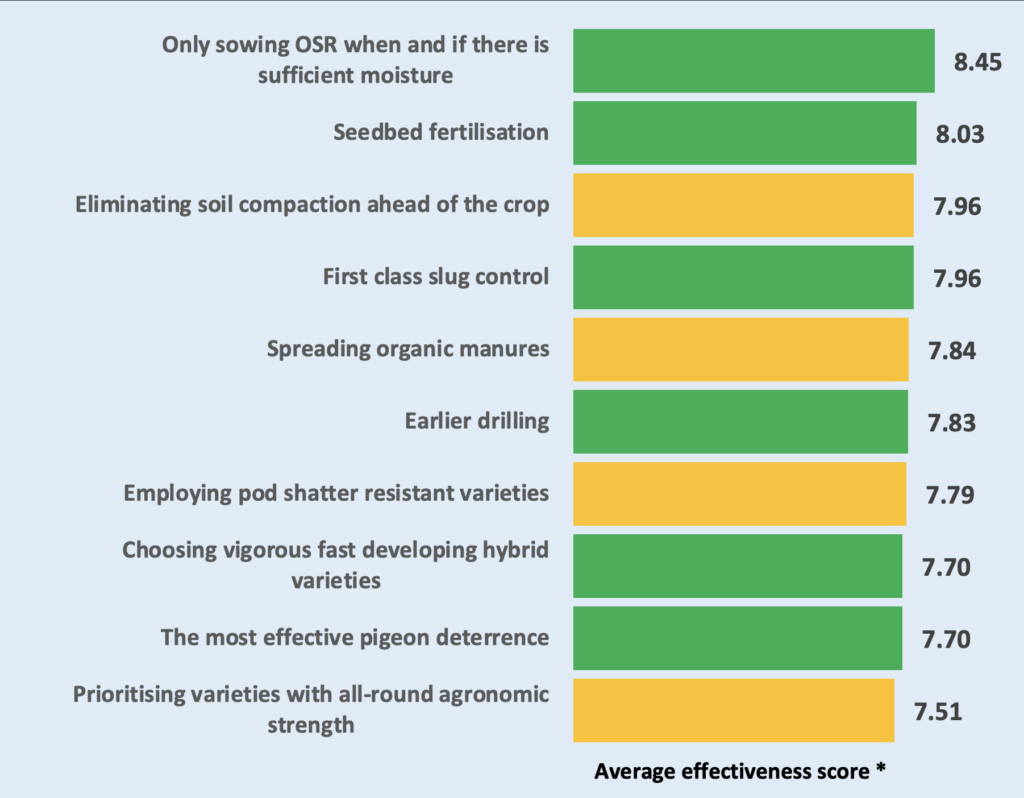
* (0= not effective: 10 = highly effective)
Source: Dekalb National Winter OSR Management Study 2022, Bayer.
These include six of the most widely used techniques, four of the reasonably widely-used ones and all three variety-related practices.
“The 10 most effective risk minimisation techniques provide clear guidance for those wishing to make the very most of their great OSR-earning opportunities in the coming season,” concludes Richard Williams.
“As all the most popular practices not rated in the tpgr
op 10 for effectiveness scored at least 7.2 for effectiveness and the rest of the widely used ones rated at 6.5 or more on our 0-10 scale, they should also figure in growers considerations moving forward.
“The limited scale of their use makes it statistically unwise to draw too many effectiveness conclusions from most of the least widely-employed practices. However, where there were sufficient numbers, double rolling and more emphasis on crop micro-nutrition both came in with relatively good average effectiveness scores of 6.9 or more while leaving long cereals stubbles and OSR volunteers as trap crops rated fairly poorly at 5.5 or less.”
